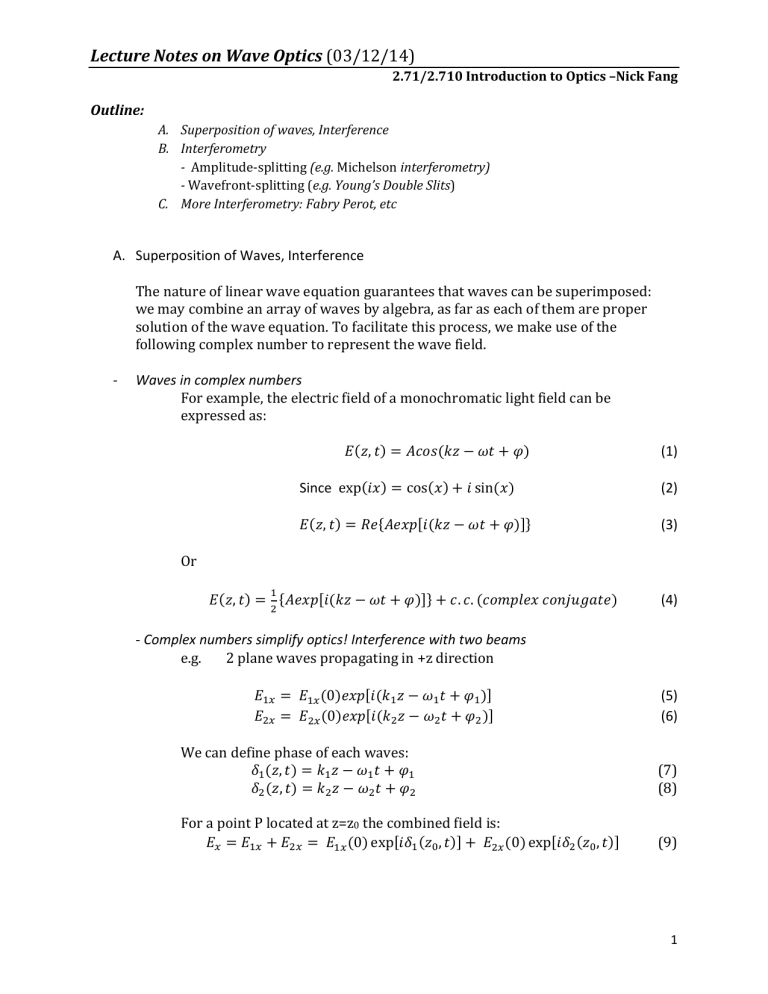
Lecture Notes on Wave Optics (03/12/14)
2.71/2.710 Introduction to Optics –Nick Fang
Outline:
A. Superposition of waves, Interference
B. Interferometry
- Amplitude-splitting (e.g. Michelson interferometry)
- Wavefront-splitting (e.g. Young’s Double Slits)
C. More Interferometry: Fabry Perot, etc
A. Superposition of Waves, Interference
The nature of linear wave equation guarantees that waves can be superimposed:
we may combine an array of waves by algebra, as far as each of them are proper
solution of the wave equation. To facilitate this process, we make use of the
following complex number to represent the wave field.
-
Waves in complex numbers
For example, the electric field of a monochromatic light field can be
expressed as:
𝐸(𝑧, 𝑡) = 𝐴𝑐𝑜𝑠(𝑘𝑧 − 𝜔𝑡 + 𝜑)
(1)
Since exp(𝑖𝑥) = cos(𝑥) + 𝑖 sin(𝑥)
(2)
𝐸(𝑧, 𝑡) = 𝑅𝑒{𝐴𝑒𝑥𝑝[𝑖(𝑘𝑧 − 𝜔𝑡 + 𝜑)]}
(3)
𝐸(𝑧, 𝑡) = 2 {𝐴𝑒𝑥𝑝[𝑖(𝑘𝑧 − 𝜔𝑡 + 𝜑)]} + 𝑐. 𝑐. (𝑐𝑜𝑚𝑝𝑙𝑒𝑥 𝑐𝑜𝑛𝑗𝑢𝑔𝑎𝑡𝑒)
(4)
Or
1
- Complex numbers simplify optics! Interference with two beams
e.g.
2 plane waves propagating in +z direction
𝐸1𝑥 = 𝐸1𝑥 (0)𝑒𝑥𝑝[𝑖(𝑘1 𝑧 − 𝜔1 𝑡 + 𝜑1 )]
𝐸2𝑥 = 𝐸2𝑥 (0)𝑒𝑥𝑝[𝑖(𝑘2 𝑧 − 𝜔2 𝑡 + 𝜑2 )]
(5)
(6)
We can define phase of each waves:
𝛿1 (𝑧, 𝑡) = 𝑘1 𝑧 − 𝜔1 𝑡 + 𝜑1
𝛿2 (𝑧, 𝑡) = 𝑘2 𝑧 − 𝜔2 𝑡 + 𝜑2
(7)
(8)
For a point P located at z=z0 the combined field is:
𝐸𝑥 = 𝐸1𝑥 + 𝐸2𝑥 = 𝐸1𝑥 (0) exp[𝑖𝛿1 (𝑧0 , 𝑡)] + 𝐸2𝑥 (0) exp[𝑖𝛿2 (𝑧0 , 𝑡)]
(9)
1
Lecture Notes on Wave Optics (03/12/14)
2.71/2.710 Introduction to Optics –Nick Fang
B. Interferometry
We often use optical interferometers to facilitate the study of interference. A few
common setups are discussed here. Based on the operation principle to split the
beams, we may find the so-called amplitude-splitting or wavefront-splitting devices.
-
Input
beam E(t)
Mirror
Michelson Interferometry
The Michelson Interferometer is
named after Albert Michelson, who
used it with Edward Morley in 1887,
in an attempt to measure the
existence of the "ether".
Output
beamE(t–t)
Translation stage
In Michelson- Morley’s famous experiment, the delay time ∆𝜏 is achieved simply by
moving a mirror along the optical axis. Moving a mirror backward by a distance L
yields a delay of:
∆𝜏 =
2𝐿
(10)
𝑐
(e.g. 300 µm of mirror displacement yields a delay of 2 × 10−12 s=2ps).
Input
beam
L2
Mirror
I0
Beamsplitter
Output
beam
I0
L1
Delay
A Michelson Interferometer as shown in left
schematic, split a beam of incident light into
two arms using a thin glass window. Both
beams travel to mirrors that are precisely
aligned to reflect them. Before recombining
them at the beam splitter, the two beams
traveled with different optical path length L1
and L2.
𝐼 = 2𝐼0 + 2𝐼0 ⟨cos (2𝜔
L1 −L2
Mirror
𝑐
)⟩
(11)
The variation of intensity as a function of the
path length L1 gives us a measure of wavelength of light! Recent effort is to apply such
technology in measurement of gravity waves.
Observation:
-
Michelson Interferometer measures (auto)-correlation in time.
To see this effect, we suppose the input light beam is not monochromatic.
Thus
𝑐
𝑐
∗
∗
𝐼 = 2 𝜀⟨𝐸𝑥 ∙ 𝐸𝑥∗ ⟩ = 2 𝜀⟨(𝐸1𝑥 + 𝐸1𝑥 (𝑡 − 𝜏)) ∙ (𝐸1𝑥
+ 𝐸1𝑥
(𝑡 − 𝜏))⟩
(12)
2
Lecture Notes on Wave Optics (03/12/14)
2.71/2.710 Introduction to Optics –Nick Fang
∗
(𝑡 − 𝜏)⟩
𝐼 = 𝐼1 (𝑡) + 𝐼1 (𝑡 − 𝜏) + 2⟨𝐸1𝑥 ∙ 𝐸1𝑥
(13)
Such auto-correlation function tells the similarity of the field over given
period of time. The Fourier transform of the auto-correlated signal yields the
Power Spectrum:
𝐹𝑇
∞
∗ (𝑡
∗ (𝜔)
− 𝜏)𝑑𝑡 ⇒ 𝐸1𝑥 (𝜔) ∙ 𝐸1𝑥
= |𝐸1𝑥 (𝜔)|2
(14)
∫0 𝐸1𝑥 ∙ 𝐸1𝑥
This is how Fourier Transform Spectroscopy (often abbreviated as FTIR) are
constructed nowadays. (See Pedrotti 21-2 for more discussion)
Interferogram
This interferogram is
very narrow, so the
spectrum
is very broad.
4000 3200 2400 1600 800
© Source unknown. All rights reserved.
This content is excluded from our Creative
Commons license. For more information,
see http://ocw.mit.edu/fairuse.
© Source unknown. All rights reserved.
This content is excluded from our Creative
Commons license. For more information,
see http://ocw.mit.edu/fairuse.
-
In the above analysis we assumed the input beams
are ideal plane waves so we only focused on
intensity variation of a single spot as the arm length
changes. In reality, a set of nested rings are often
observed on the receiving screen as the pattern on
right. This is due to the variation of phase as a
function of momentum difference (𝑘1 − 𝑘2 )𝑧.
-
Young’s Double Slit Interferometry
X
X’
observation
point x’
x=x0
Z
x=−x0
incoming
plane wave
(on-axis)
opaque
screen
To analyze Young’s experiment,
we assume the screen X with
two narrow slit is illuminated
with a monochromatic plane
wave. After the slits, two
cylindrical waves are excited.
This creates fringes at the
observation plane X’ , after
travelling a distance 𝑧 = 𝑙.
z =l
the phase difference of the two waves becomes:
For a position x’ on the screen,
3
Lecture Notes on Wave Optics (03/12/14)
2.71/2.710 Introduction to Optics –Nick Fang
𝛿1 − 𝛿2 = 𝑘(𝑟1 − 𝑟2 ) + (𝜑1 − 𝜑2 )
(15)
where 𝑟1 = √(𝑥 ′ − 𝑥0 )2 + 𝑙 2 , 𝑟2 = √(𝑥 ′ + 𝑥0 )2 + 𝑙 2 . When the slits are arranged
symmetrically and the incoming plane wave is at normal incidence, then 𝜑1 − 𝜑2 =
0
In a typical experiment the screen is placed far away from the slits (𝑙 ≫ 𝑥0 ) so we
can further take approximation:
𝑟1 = 𝑙√1 +
𝑟2 = 𝑙 √1 +
(𝑥 ′ −𝑥0 )2
𝑙2
(𝑥 ′ +𝑥0 )2
𝑙2
≈ 𝑙 (1 +
≈ 𝑙 (1 +
(𝑟1 − 𝑟2 ) = −
(𝑥 ′ −𝑥0 )
2
2𝑙 2
(𝑥 ′ +𝑥0 )
2𝑙 2
2𝑥′𝑥0
2
)
(16)
)
(17)
(18)
𝑙
In order for the constructive interference to occur, cos(𝛿1 − 𝛿2 ) = 1, then
𝑘(𝑟1 − 𝑟2 ) = −𝑘
2𝑥0 𝑥 ′
𝑙
= 2𝑚𝜋
(19)
𝑚 = 0, ±1, ±2, …. are called order number.
This gives rise to the famous condition:
2𝑥0 𝑥 ′ = 𝑚𝑙𝜆
(20)
Therefore Young’s experiments directly measured the wavelength of light (in 18
century!)
Note: Generally fringes will form by two or more beams crossing at an angle. To
quantify that we can modify our phase term for the crossing beams:
𝛿1 (𝑥, 𝑧, 𝑡) = 𝑘1𝑥 𝑥 + 𝑘1𝑧 𝑧 − 𝜔1 𝑡 + 𝜑1
or in terms of incident angle θ:
𝛿1 (𝑥, 𝑧, 𝑡) = 𝑘1 𝑥𝑠𝑖𝑛𝜃1 + 𝑘1 𝑧𝑐𝑜𝑠𝜃1 − 𝜔1 𝑡 + 𝜑1
𝛿1 − 𝛿2 = (𝑘1 𝑠𝑖𝑛𝜃1 − 𝑘2 𝑠𝑖𝑛𝜃2 )𝑥 + (𝑘1 𝑐𝑜𝑠𝜃1 − 𝑘2 𝑐𝑜𝑠𝜃2 )𝑧 + (𝜑1 − 𝜑2 )
(21)
(22)
(23)
Fringes can vary both on x and z directions!
Note: Young’s double slit experiment measures the correlation in space.
Assuming the input light beam is not a plane wave (i.e. inhomogeneous), at x’=0
we measure the interference:
𝑐
𝑐
∗
∗
𝐼 = 2 𝜀⟨𝐸𝑥 ∙ 𝐸𝑥∗ ⟩ = 2 𝜀⟨(𝐸1𝑥 (𝑥 − 𝑥0 ) + 𝐸1𝑥 (𝑥+𝑥0 )) ∙ (𝐸1𝑥
(𝑥 − 𝑥0 ) + 𝐸1𝑥
(𝑥 + 𝑥0 ))⟩ (24)
-
4
Lecture Notes on Wave Optics (03/12/14)
2.71/2.710 Introduction to Optics –Nick Fang
∗
(𝑥 + 𝑥0 )⟩
𝐼 = 𝐼1 (𝑥 − 𝑥0 ) + 𝐼1 (𝑥 + 𝑥0 ) + 2⟨𝐸1𝑥 (𝑥 − 𝑥0 ) ∙ 𝐸1𝑥
(25)
Such correlation function tells the similarity of the field over a given spatial
period. This effect is often used to measure the coherence of a remote star
under the telescope, although the radiation is thought to be randomly
distributed. A daily life example is the spatial coherence of ripples in the pool
(“Spatial coherence from Ducks” by Emil Wolf et al, Physics today 2010).
-
Comparison between Michelson and Young’s double slits:
Both can be regarded as interference of two spherical waves, but observed in
different directions.
Image of wavefront splitting inferometry removed due to copyright restrictions.
-
Other wavefront splitting interferometry similar to Young’s Double slits:
o Lloyd’s Mirror
o Fresnel’s biprism
o Fresnel’s mirror
o Billet’s split lens
C. More examples of Interferometry
-
Thin Film interference
5
Lecture Notes on Wave Optics (03/12/14)
2.71/2.710 Introduction to Optics –Nick Fang
- Fabry-Perot Interferometry
t’(rr’)2tE0e2id
2tE
r’(rr’)
0
Consider two parallel reflective
tr’(rr’)tE0e2id
surfaces separated by distance d,
(rr’)2tE0
t’rr’tE0eid
the first one has a amplitude
r’rr’tE
0
tr’tE0eid
transmission and reflection
rr’tE0
coefficient t and r, and the
r’tE0
t’tE0
second has amplitude
rE0
transmission and reflection
tE0
E0
coefficient t’ and r’. Multiple
r, t
r’, t’
reflections between the two
surfaces results in two series of
reflected and transmitted terms. Due to the round trip travel path, there is a phase
difference between successive transmitted terms:
(26)
𝛿0 = (2𝑘𝑧 𝑑)
The transmitted series is
𝐸𝑡 = exp(𝑖𝛿0 /2)(𝑡 ′ 𝑡𝐸0 + 𝑡 ′ (𝑟𝑟 ′ )𝑡𝐸0 exp(𝑖𝛿0 ) + 𝑡 ′ (𝑟𝑟 ′ )2 𝑡𝐸0 exp(2𝑖𝛿0 ) + ⋯ )
′
𝐸𝑡 = 𝑡 𝑡𝐸0 exp(𝑖𝛿0 /2)[1 +
𝐸𝑡 = 𝑡
′
(𝑟𝑟 ′ )
exp(𝑖𝛿0 ) +
(𝑟𝑟 ′ )2
exp(2𝑖𝛿0 ) + ⋯ ]
′ 𝑛
𝑡𝐸0 exp(𝑖𝛿0 /2) ∑∞
𝑛=0(𝑟𝑟 ) exp(𝑖𝑛𝛿0 )
𝐸𝑡 =
𝑡 ′ 𝑡exp(𝑖𝛿0 /2)𝐸0
(27)
(28)
(29)
(30)
1−𝑟𝑟′ exp(𝑖𝛿0 )
The transmitted irradiance is given by:
𝑇′𝑇𝐼0
𝐼𝑡 = |1−𝑟𝑟′
(31)
exp(𝑖𝛿0 )|2
The denominator of the last result can be expressed as:
|1 − 𝑟𝑟′ exp(𝑖𝛿0 )|2 = (1 − 𝑟𝑟′ exp(𝑖𝛿0 ))(1 − 𝑟 ∗ 𝑟 ′∗ exp(−𝑖𝛿0 ))
= 1 − (𝑟 𝑟 ′ exp(𝑖𝛿0 ) + 𝑟 ∗ 𝑟 ′∗ exp(−𝑖𝛿0 )) + 𝑅𝑅′
= 1 − 2√𝑅𝑅 ′ cos(𝛿) + 𝑅𝑅′
2
= (1 − √𝑅𝑅 ′ ) + 2√𝑅𝑅 ′ (1 − cos(𝛿))
2
𝛿
= (1 − √𝑅𝑅 ′ ) + 4√𝑅𝑅 ′ sin2 (2)
Where 𝛿 = (2𝑘𝑧 𝑑) + 𝜙𝑟 + 𝜙𝑟′
(32)
(33)
We define the coefficient of finesse F:
6
Lecture Notes on Wave Optics (03/12/14)
2.71/2.710 Introduction to Optics –Nick Fang
4√𝑅𝑅 ′
ℱ=
(34)
2
(1−√𝑅𝑅 ′ )
To express the general form of It:
𝐼𝑡 =
𝑇′𝑇𝐼0
2
(1−√𝑅𝑅 ′ )
[
1
𝛿
2
1+ℱsin2 ( )
]
(35)
Applications: Fabry-Perot cavities are often designed to distinguish closely spaced
spectral lines of a gas medium. Higher values of Finesse F give a sharper
transmission pass band and greater spectral resolution. To find the half-width of the
pass band, we solve:
1
giving
𝛿
1+ℱsin2 ( )
2
𝛿1/2
𝑠𝑖𝑛 (
2
=
)=
1
2
1
√ℱ
(36)
(37)
Figure 8.9 from Pedrotti: Transmittance of Fabry-Perot Cavity.
© Pearson Prentice Hall. All rights reserved. This content is excluded from our Creative
Commons license. For more information, see http://ocw.mit.edu/fairuse.
7
MIT OpenCourseWare
http://ocw.mit.edu
2SWLFV
Spring 2014
For information about citing these materials or our Terms of Use, visit: http://ocw.mit.edu/terms.





